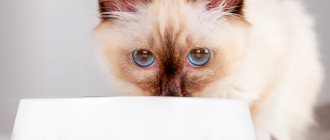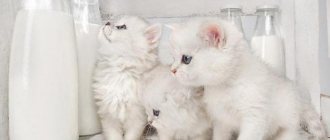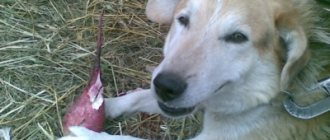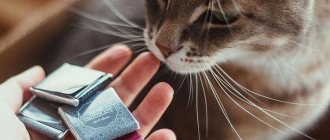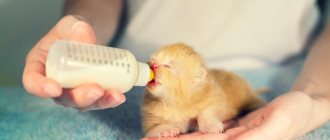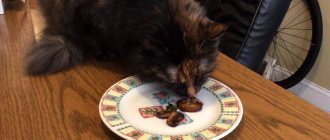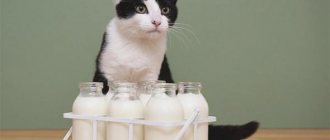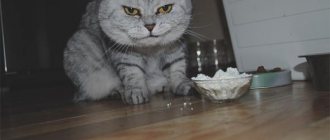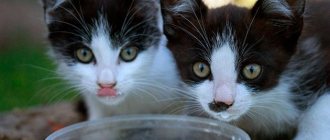For many decades, there has been a well-founded opinion about the need to introduce milk into the diet of domestic cats. In recent years, experts have been destroying stereotypes that have developed over the years and strongly recommend removing this product from the menu of an adult cat.
How to make the right decision and make your beloved pet’s diet as beneficial as possible for him? In our article we will discuss important questions: can cats have milk, what are its benefits, and is there any harm in such nutrition when feeding an adult pet.
Milk in the diet of kittens
At least until 2 months, the kitten's main food product is mother's milk. It contains all the elements necessary for intensive growth and development and provides immune protection for the baby’s body.
If for some reason the kitten is left without mother's milk, the only complete source of replacement can only be special dry formulas sold in specialized pet salons. For example, Beaphar Kitty-Milk or Royal Canin Babycat Milk.
In the absence of special mother's milk substitutes, you can give the kitten infant formula or goat's milk for a short time. Whole cow's milk is not a complete and correct substitute and can be harmful to the baby.
This drink was originally created by nature for feeding calves. Despite the fact that it contains many useful substances and amino acids, it also contains components that are not intended for the cat's body.
Cow's milk proteins are very poorly absorbed by kittens. In addition, store-bought milk is obtained from cows whose diet is based on industrial feed, so the content of pesticides and antibiotics in the drink will be very high.
Much higher than the permissible standards for the cat's body in cow's milk and casein with lactose. They are also difficult for small kittens to digest.
Goat's milk, although not such a complete replacement as mother's milk, is much closer to it in composition. It is only advisable to dilute it with boiled water to reduce fat content.
When purchasing a special cat's mother's milk substitute at a pet store, you should consider:
- Manufacturer's brand. It is advisable to choose only those that have good reviews from veterinarians and cat nutritionists.
- Breed of the kitten. For example, Maine Coons, Pixie Bobs, and some other varieties need more high-calorie nutrition.
- Fat content of the mixture. Ideally, it should not exceed 9%.
If the kitten is bottle-fed, after a month you can slowly introduce meat purees into its menu; by 2-3 months, milk should no longer be the main dish in the baby’s daily diet.
And by six months, this drink must be completely excluded from the kittens’ diet or replaced with another product, for example, kefir, since as cats grow older they lose the ability to absorb milk sugar.
How to keep milk safe
Bacteria are killed by heat. Methods for disinfecting a product differ in temperature values; the higher they are, the fewer pathogens remain:
- pasteurized at 65 °C;
- boil at 100 °C;
- sterilize at temperatures above 100 °C for 20 minutes;
- during ultra-pasteurization, it is heated to 135 °C, then cooled sharply.
The nutritional value of milk decreases after processing: the higher the temperature, the less beneficial there is in the final product.
Types of milk in a cat's diet
The most popular types of milk that owners can offer their pets are cow's and goat's.
Their comparative composition is given in the table.
| Index | Cow's milk | Goat milk |
| Fat content | 2,2 – 6,8 % | Average 4.5% |
| Vitamins | A; B1; B2; B6; B12; D; C. | A, D, E, C, B1, B2, B4, B5, B6, B12, H, PP, nicotinic acid. |
| Microelements | Calcium, potassium, phosphorus. | Calcium, potassium, phosphorus, magnesium, sodium, molybdenum. |
| Lactose content | High. | Minimal. |
| Calorie content, ml/100 g | 60 | 68 |
Despite the fact that goat milk has a high fat content, its composition is basically similar to cat and human breast milk, it contains more proteins, micro- and macroelements, and higher calorie content. At the same time, there is practically no alpha lipase, which causes the formation of fatty deposits.
Therefore, goat's milk is much preferable in pet nutrition than cow's milk:
- easier to digest;
- contains many lacto- and bifidobacteria, which improve digestion and gastrointestinal function;
- hypoallergenic, as it contains no proteins;
- minimal lactose content;
- lots of vitamins and minerals.
How to tell if your cat is lactose intolerant
If your pet prefers to enjoy milk from time to time, but has not noticed any problems with its absorption, you can slightly diversify the cat’s diet. Most often, owners treat unsterilized domestic cats with cow's and goat's milk; less often, they give their pets store-bought milk or even dry diluted milk.
Goat's milk is a product high in riboflavin (vitamin B2), vitamin B1 and vitamin A. It is low in fat and is easier and faster absorbed by the cat's body. It has been established that intolerance to the proteins contained in goat's milk occurs much less frequently in animals. Sheep milk has approximately the same properties.
Cow
Cow's milk is a high-calorie product with high nutritional value. It is allowed to treat representatives of the cat family with it only if the animals do not have intolerance to the protein contained in this product.
Shop
Store-bought milk from a carton is one of the few products that not every cat will drink. Both in terms of nutritional value and taste characteristics, a store-bought product usually loses to natural milk. However, it is allowed to occasionally treat an animal to it (of course, if it does not have lactose intolerance).
To answer the question whether a kitten can be given milk, you need to understand how its digestion works. From a scientific point of view, cats fall into the following categories:
- Class: Mammals;
- Squad: Predatory;
- Family: Felines.
Nature has provided that the best nutrition for a newborn kitten is its mother's milk. A mother cat, like a true mammal, feeds her babies with milk for up to 3 months. During this time, a special enzyme, lactase, is produced in the kittens’ small intestine, which allows them to digest lactose (milk sugar).
When the kitten is 1 month old, the mother begins to gradually introduce him to solid food. They try meat, but breastfeeding does not stop. We must not forget: cats are predators. The kitten's body is growing and preparing for adulthood. Instead of lactase, proteases begin to be produced - enzymes responsible for the breakdown of proteins.
By 3 months, the cat has finished breastfeeding the kitten, and it can be given meat food. Lactase is no longer produced because there is no need for milk.
Note: in very rare cases, the gastrointestinal tract of adult animals may retain the ability to produce small amounts of lactase and digest milk.
The following mechanism works in the cat’s body: she drinks milk, but lactose is not broken down by lactase and passes through the small intestine undigested. Next, milk sugar attracts water and ends up in the large intestine, where bacteria try to process it. At this time, carbon dioxide, hydrogen and other substances that cause fermentation are released.
If your cat tolerates milk well and will never refuse it, even after listening to a lecture on lactose, calculate its daily intake of this treat: 10-15 ml per 1 kg of weight. If your cat doesn’t digest cow’s milk well, but the desire to pamper her with something delicious is irresistible, buy low-lactose milk from cat food manufacturers.
Important: dry cat food can only be combined with water. Do not try to diversify your “dry” diet with milk - this can lead to the formation of deposits in the bladder and kidneys, and increased stress on the liver and other organs. If your pet eats “natural” food, you can treat her with fermented milk products
Give preference to low-fat cottage cheese, sour cream, fermented baked milk and kefir. Cheese should be low fat and unsalted
If your pet eats “natural” food, you can treat her with fermented milk products. Give preference to low-fat cottage cheese, sour cream, fermented baked milk and kefir. Cheese should be low fat and unsalted
Pay attention to your pet’s well-being - let the treats bring only benefits!
After weaning from the mother, cats stop producing the lactase enzyme. Accordingly, the cat’s body stops absorbing milk normally. If you give dairy products to a cat, intestinal problems may appear, namely: diarrhea, bloating, and sometimes even vomiting. Most adult cats cannot digest lactose and cause discomfort for your pet.
Is milk acceptable in the diet of an adult cat - benefit or harm?
Veterinarians and nutritionists advise excluding milk from a cat’s diet from 6 months, and some experts suggest doing this earlier - as early as 4 months.
This is due to the fact that this product contains a special element in huge concentration - milk sugar. Its breakdown is carried out in the cat's body under the influence of the enzyme lactose.
The body of any mammal produces quite a lot of it in infancy and childhood and produces practically none at all in adulthood.
The consequence of feeding an adult cat milk, especially cow's milk, is a malfunction of the gastrointestinal tract, the occurrence of dyspeptic symptoms - nausea, vomiting, diarrhea.
This theory is confirmed by almost all experts - product rejection occurs in most individuals, but there are exceptions to the rule.
Some adult and even elderly pets happily drink milk without any consequences for the proper functioning of the body. This is due to the individual characteristics of specific individuals. This means that it is in their body that a lot of lactose is still produced and the breakdown of milk sugars occurs successfully.
All adult animals like the taste of milk, but numerous studies have confirmed that it does not bring any benefit to the pet. Some cats, even in the absence of dyspeptic symptoms, may develop an allergic reaction when feeding them milk.
Thus, despite the assertion of some scientists about the indispensability of cow's milk in the diet of cats, most experts recognize this product as harmful and unacceptable in the diet of adult pets:
- The high calorie content of milk can lead to imbalance in the body and ultimately lead to obesity.
- The high content of casein and lactose does not allow the product to be completely absorbed.
- An extremely high concentration of elements that are unacceptable in the diet of an adult animal contributes to the development of allergies.
- Intolerance to milk sugars by the cat's body leads to indigestion, flatulence, bloating, indigestion, chronic diarrhea and dehydration.
General information
Problems and questions do not arise in cats with milk as long as the young body produces the lactase enzyme, which breaks down the sugar from milk - lactose. As cats age, the enzyme becomes less and less and, as a result, it may completely disappear from the body, since the process of evolution does not provide for long-term feeding of offspring with milk.
As an adult, a non-domestic cat no longer has contact with milk and feels great without consuming it. A domestic cat has a chance to be fed milk and dairy products. This is where the question arises: can cats have milk even if the animal has already grown up?
Whole milk contains many beneficial components:
- Calcium
- Fatty acid
- Lactose
- Lecithin
- Cholesterol
- Vitamin A and D
- Phosphorus
All of these are useful substances, but due to the peculiarities of adult digestion, all of them may not be absorbed by the cat’s stomach, since the lack of lactase in milk causes diarrhea before it is digested.
Compatibility of milk with dry food
Another question that concerns owners of animals that consume milk is its compatibility with dry formulas.
Ready-made industrial food is a completely balanced product containing all the necessary elements, and there is no need for your cat to drink it with milk.
With the simultaneous intake of milk and dry formulas, an excess of nutrients and microelements appears in the cat’s body, which settle in the form of deposits on the walls of the bladder and kidneys, leading to the development of urolithiasis. The liver also suffers, since this protective barrier of the body is filled with toxins. This product is especially dangerous for castrated cats and sterilized females.
Pets should drink food only with clean running water.
Cow's milk, even if replaced with goat's milk, which is less dangerous for cats, is an element of natural nutrition, and mixing it with feeding dry industrial food, according to veterinarians, is unacceptable.
What and how to feed a small kitten
If you cannot find a nursing cat, the best milk replacer is a special mixture that is sold at any pet store.
In terms of its composition, it is complete nutrition for the cub, which will allow it to grow and develop normally. Artificial feeding should occur in the same way as it would happen with a mother cat:
- The feeding area should be warm and quiet;
- the baby should lie on his tummy;
- It is better to use a special pacifier, which is sold in a pet store;
- The angle of the nipple should be about 45°;
- The baby should not be forced to eat more than it wants;
- for the first two weeks, food must be given every two to three hours;
- You can start feeding solid food closer to the month.
You should know that the kitten cannot go to the toilet on its own for some time. If there is no cat nearby, then you need to help him. To do this, after feeding, you need to stroke the kitten’s tummy and rub the anus with a cotton swab. If this is not done, the body will become intoxicated and death may occur. Over time, the baby will grow up and learn to do everything himself.
Sometimes a critical situation may arise when there is no pet store nearby and it is impossible to buy a special mixture. In this case, you should follow some tips when feeding cat babies:
- you can feed with infant formula, but add a little more water than is written in the instructions for it;
- Goat's milk is preferable to cow's milk, but either of them must be diluted with water;
- It is recommended to add a little whipped egg white to the mixture, but not more than 1/5;
- you can give your kitten kefir;
- Instead of a bottle, you can use a pipette or a syringe without a needle, but this option is only suitable for extreme cases. Care must be taken to ensure that the mixture does not enter the respiratory tract.
After three months, milk feeding ends completely and the already grown cat should be given meat food.
Replacing milk with fermented milk products
If the cat is a dairy lover and is on a natural diet, it is better to gradually replace this product with a fermented milk menu.
Kefir, fermented baked milk, natural yoghurts not only do not contain milk sugars, but are also enriched with lactic acid bacteria, which have a beneficial effect on digestion and the functioning of the entire gastrointestinal system of the cat as a whole.
There is no lactose in these products; it is what is converted into lactic acid during fermentation.
Using various types of fermented milk products, you can regulate and eliminate intestinal problems in your pet. So, for example, in case of regular constipation, fresh kefir will help, and in case of diarrhea, “old” (two-day old) kefir.
You can offer your cat milk without or with low lactose content, but usually such products do not delight your pet.
When choosing kefir, or better yet biokefir or fermented baked milk, you should pay attention to the fat content in them. It shouldn't be high. That is why you should not often offer your cat high-calorie cottage cheese or cheese, much less sour cream.
It is unacceptable to feed your pet sweet yoghurts and curds containing a lot of sucrose. Sugar is another harmful and dangerous human product for cats.
Why raw milk can be dangerous
Milk is a favorable nutrient medium for the proliferation of harmful microorganisms; the following types are most often found in it:
- Bacillus cereus is a conditionally pathogenic bacteria that produces toxins. With strong reproduction it causes poisoning. Spores are killed only by boiling.
- Campylobacter affects the digestive tract, causes diarrhea, and dies at 60 °C.
- Pathogenic strains of E. coli cause eating disorders with diarrhea and vomiting.
- Pathogenic forms of staphylococci provoke vomiting and diarrhea.
- Listeria affects nerve cells; in severe cases, encephalitis and meningitis develop after infection.
- The bacterium survives at temperatures of 4–50 °C and is stored in refrigerators.
- Coxiella Burnet does not cause acute symptoms in cats, but is transmitted to humans through it.
Pathogens enter milk from the body of infected cows or from the environment when the product is improperly stored.
Reviews from veterinarians
Thus, the opinion of most veterinarians boils down to the following:
- It is not forbidden to feed your pets milk if it is normally absorbed by his body. But you should not give them this product in melted form (high fat content), cream and condensed milk.
- It is recommended to cook porridge in water, even semolina.
- The rest of the cats can be given low-fat and unsweetened fermented milk products, again, provided that they accept it normally.
But these products are under no circumstances mixed with ready-made industrial feed.
With a natural diet, the amount of dairy or fermented milk products per day should not exceed 20-30% of the daily diet, because a cat is primarily a predator. And her diet should be dominated by animal proteins, specifically meat. This is the best treat for any pet.
All the arguments for and against
It is impossible to say unequivocally whether milk will be beneficial for a particular cat. It all depends on the individual characteristics of the body, as well as on the usual diet. Milk does not go well with some foods; consuming them at the same time will inevitably lead to indigestion, even in absolutely healthy pets. You should not give milk and fermented milk products when feeding special cat food.
You need to give the animal natural products - country products, not purchased on store shelves or supermarkets. Their composition is far from natural products, the beneficial properties are reduced or completely absent. If the animal’s body does not tolerate cow’s milk, you can try goat’s or sheep’s milk. If there are unpleasant manifestations in this case, the product should be discarded. The situation is similar with sour milk. The main argument is why you can’t give milk to a cat, lactose intolerance, fat intolerance. If the body easily copes with the components, there are no prohibitions.
Goat or cow's milk?
Another question that causes a storm of emotions among “experts”. The argument goes something like this: “A cat that eats good food and drinks water will live and not get sick, an animal that drinks only cow’s milk will die from exhaustion.” We will not argue that milk is not able to provide the body with a full range of useful substances and microelements; at least it does not contain pure carbohydrates. But can you really allow the comparison of a natural and an artificially created product to be fair? According to this logic, if you do not feed your ward good “drying”, then he will suffer, and this is pure delusion. A natural diet is healthier, look at the feed advertisements, what is the main argument? — Consists of environmentally friendly products, like homemade ones, contains natural meat. Milk cannot be kept dry because it is too nutritious for the proliferation of microorganisms; in other words, it is not conducive to long-term storage.
There are fewer “scares” about goat milk, but there is an assumption that marketers are not yet ready to argue with scientists and as soon as a sufficient number of “arguments” are collected, the war will begin. The advantages of homemade goat's milk over cow's milk are as follows:
Fattier, but better digestible - the special composition of goat milk protects the product from “clumping” of fats under the influence of stomach acid. Cow's milk fat molecules (caseins) are larger and form “balls”, making the digestion process more difficult.
“Liver” - unboiled goat milk contains more lacto- and bifidobacteria, has a beneficial effect on digestion, the state of intestinal microflora and reduces (!) the risk of an allergic reaction.
Contains less lactose - that is, it is easier to digest for adult animals. By the way, goat's milk is hypoallergenic a priori, since it does not contain proteins that cause allergies when consuming cow's milk. That is, if a cat has an acute reaction to goat's milk, it is worth thinking about the reasons, they are clearly not lactose.
More vitamins and microelements, the list is approximately the same, but depends on the nutrition of the cow/goat.
In conclusion, one more point needs to be highlighted - homemade is always better than industrial
, this applies not only to milk. If you have the opportunity to buy only “store-bought” milk and your cat has an acute reaction to it, then it’s really better to eliminate the product completely! Don’t blindly believe in arguments from supposed experts; always look at the situation as a whole! This applies to questions about the benefits of milk, dairy products, cheeses, cottage cheese and all other products. It’s better to pamper your pet with a saucer of homemade cow’s milk than low-quality cheese with the proud name “feta”. A spoonful of rural sour cream is better than 100 grams of low-fat store-bought surrogate. It is better to give your client 2-3 grams of the product and observe the reaction than to blindly believe in prohibitions invented by someone and dubiously justified.
The babies of all animals drink their mother's milk after birth, including kittens. Naturally, this is the most indispensable product for newly born little kittens. Thanks to him, they receive all the substances necessary for growth and development.
Mother's milk is very well absorbed, beneficial, and the babies feel just great. Is it possible to give them milk at a more mature age, if you replace mother's milk, for example, with cow's milk?
Having studied this issue, scientists came to the conclusion that, in principle, drinking milk is not advisable for any adult creature, especially for cats, for the simple reason that in nature cats do not feed on milk, with the exception of babies who drink mother's milk. Their small body is ready only for milk nutrition, since it produces a sufficient amount of enzymes to process lactose, that is, milk sugar.
As cats age, the production of enzymes noticeably slows down, milk is poorly digested and gives way to other products that are no less important for their growth and health. Of course, a certain percentage of enzymes are retained in the animal’s body, but this is personal for each individual.
A cat can drink milk poured into it, but how it subsequently tolerates it will directly depend on the presence of certain enzymes in the body. In most cases, the consequences are not very good, and it is better to save your pet from unnecessary troubles, taking into account the advice of feminologists and veterinarians.
What are substitutes and their composition
For artificial feeding of kittens, companies producing ready-made diets have released a special line of products called “cat milk replacers.” This product is most similar in composition to cat colostrum and includes the following elements:
- taurine (amino acid);
- complex of vitamin and mineral components;
- fatty acids (omega-3 and omega-6).
It is extremely important for owners to monitor the ratio and proportions of the ingredients contained in the substitute in this product. A deficiency of certain components, in particular omega fatty acids, can cause the development of serious pathologies in a kitten.
Substitutes are sold in dry, powder form, and are also available in liquid form. It is believed that the liquid product is more useful and is better absorbed. However, it should be remembered that its shelf life is much shorter than that of the substitute in dry form.
